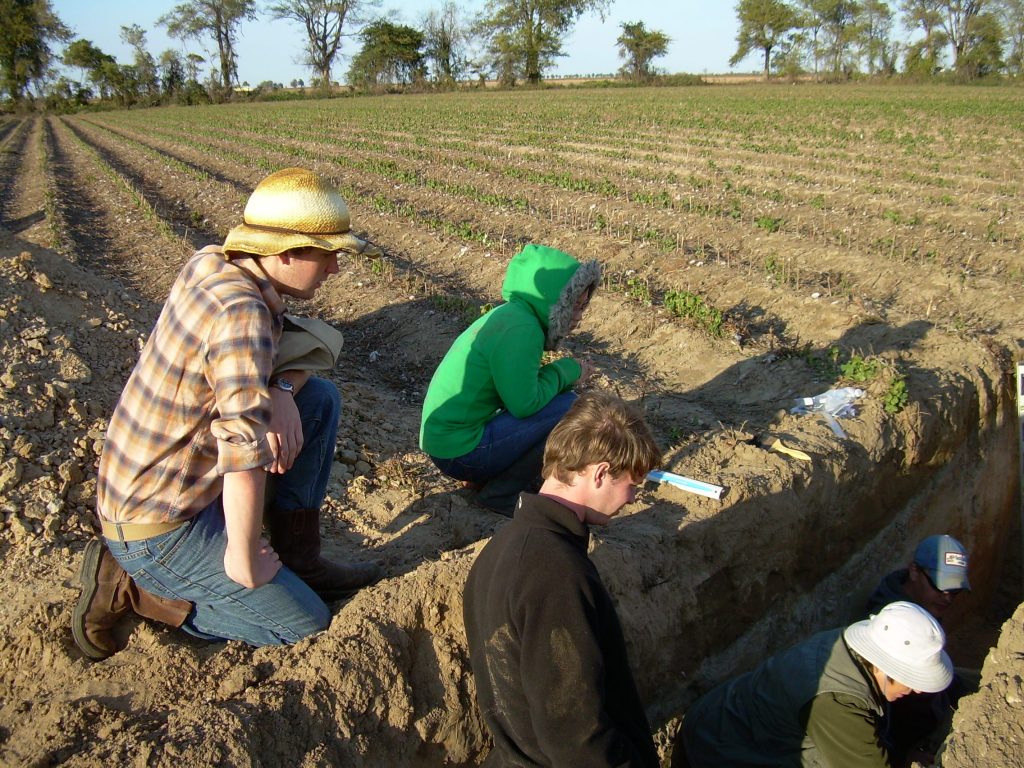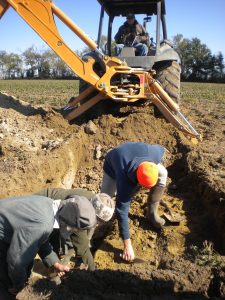
Geology students Yuri Rupert, Yeng Peng, and Joel Abrahams look on as M. Tuttle points out liquefaction features exposed in trench excavations.
Shallow subsurface geophysical techniques can be used to locate buried earthquake-induced liquefaction features and to target optimal areas for paleoseismic excavations. This work has involved close collaboration with experts in paleoseismology (M. Tuttle and Associates) and archeology (R. Lafferty, Mid-Continent….). Our current project, funded by the Nuclear Regulatory Commission through M. Tuttle and Associates, has two main components:
(1) creation of a training document describing the use of paleoliquefaction features in earthquake hazard analyses, and
(2) fieldwork at additional archeological sites to enhance understanding of the timing and location of prehistoric earthquakes.
Selected References:
Tuttle, M. P., L. W. Wolf, P. Mayne, K. Dyer-Williams, and R. Laferty, Paleoliquefaction Studies, U.S. Nuclear Regulatory Commission, Office of Nuclear Regulatory Research, Washington DC, in review.
Hardesty, K., L. W. Wolf, P. Bodin, 2010, Noise to Signal: A microtremor study at liquefaction sites in the New Madrid seismic zone, Geophysics, v.75, B83-90, DOI:10.1190/1.3374357.
Wolf, L. W., M. P. Tuttle, and S. Park, 2006, Geophysical surveys of earthquake-induced liquefaction deposits in the New Madrid seismic zone, Geophysics, v. 71, n.6, B223-B270.
Wolf, L.W., Lee, M.-K., Browning, S., and Tuttle, M., 2005, Numerical analysis of overpressure development in the New Madrid seismic zone, Bulletin of Seismological Society of America, 95, 135-144.
Wolf, L. W., Park, S., Browning, S., and Tuttle, M., 2004, Locating earthquake-induced liquefaction deposits at Native American cultural sites using non-invasive geophysical surveys, in Proceedings of the Symposium on the Application of Geophysics to Environmental and Engineering Problems, Environmental and Engineering Geophysics Society, Colorado Springs.
Tuttle, M. P., Schweig, E. S., Sims, J. D., Lafferty, R. H., Wolf, L. W., and Haynes, M. L., 2002, The earthquake potential of the New Madrid seismic zone, Bulletin of Seismological Society of America, 92, 2080-2089.
Tuttle, M. P., J. Collier, L. W. Wolf, and R. H. Lafferty, 1999, New evidence for a large earthquake in the New Madrid seismic zone between A.D. 1400 and 1670, Geology, v. 27, p. 7771-7774.
Barnes, A., M. Tuttle, L. Wolf, R. Lafferty, W. Hoyt, E. Schweig, 1999, Evidence for two prehistoric earthquakes in the New Madrid seismic zone, Seismological Society of America Eastern Section Abstracts, October 1999, University of Memphis, TN, p. 34.
Wolf, L., J. Collier, P. Bodin, and M. Tuttle, 1998, Geophysical reconnaissance of earthquake-induced liquefaction features in the New Madrid seismic zone, Journal of Applied Geophysics, v. 39, p. 121-129.

